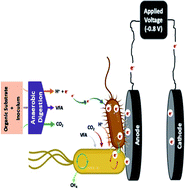Electron-regulated flux towards biogas upgradation – triggering catabolism for an augmented methanogenic activity
Abstract
Electromethanogenesis (EM) process was specifically designed to increase the conversion efficiency of organic substrates towards methane production and was further evaluated towards biogas upgradation applications. Four single-chambered EM systems were operated using designed synthetic wastewater (carbon source: 10 g L−1) to comparatively analyze the effect of applied voltage (AV −0.8 V; CC 100 Ω) and electrode placement on methanogenesis. The experiments were performed in three phases: the biomethanation phase (BM) (without electrodes assembly), electrode phase (MESOC; with electrodes assembly in an open circuit operation) and EM phase (MESCC/AV; electrodes assembly in a closed circuit or applied voltage operation). Electrode placement with a submerged anode and variations in the position of the cathode [partially air-exposed cathode; AV (R1/MESAV) and CC (R2/MESCC)] and completely submerged cathode [AV (R3/IE-MESAV) and CC (R4/IE-MESCC)] were evaluated. The results for the EM phase showed higher total biogas formation in R3/IE-MESAV (1.12 L), followed by R1/MESAV (0.91 L), R4/IE-MESCC (0.88 L) and R2/MESCC (0.59 L). Higher methane content was observed in R3/IE-MESAV (0.88 L) with a conversion efficiency of 76%, followed by R1/MESAV (0.66 L; 60%), R4/IE-MESCC (0.60 L; 56%) and R2/MESCC (0.37 L; 34%). EM operation depicted higher CH4 fraction with the co-generation of lower fractions of H2 and CO2 [R3/IE-MESAV (CH4-78%; H2-5%; CO2-17%), R1/MESAV (CH4-73%; H2-3%; CO2-22%), R4/IE-MESCC (CH4-68%; H2-5%; CO2-28%), R2/MESCC (CH4-63%; H2-4%; CO2-34%)] compared to control operation (CH4-61%; H2-4%; CO2-33%). The polarized microenvironment provided during EM (CC/AV) significantly contributed to biogas upgradation with a simultaneous CO2 reduction as compared to the BM and MESOC phases. Electrochemical characterization showed a high regulatory influence of the electron flux in R3/IE-MESAV, which helped to increase CO2 conversion/utilization compared to other conditions. EM influenced direct interspecies electron transfer (DIET), creating a microbe–electrode synergy leading to neutralize the disruptors influence (from side reactions) on final product formation. This study provides a specific strategy for increasing the overall methane yields with the influence of in situ/ex situ potential, while overcoming the limitations of methanogenesis.



 Please wait while we load your content...
Please wait while we load your content...